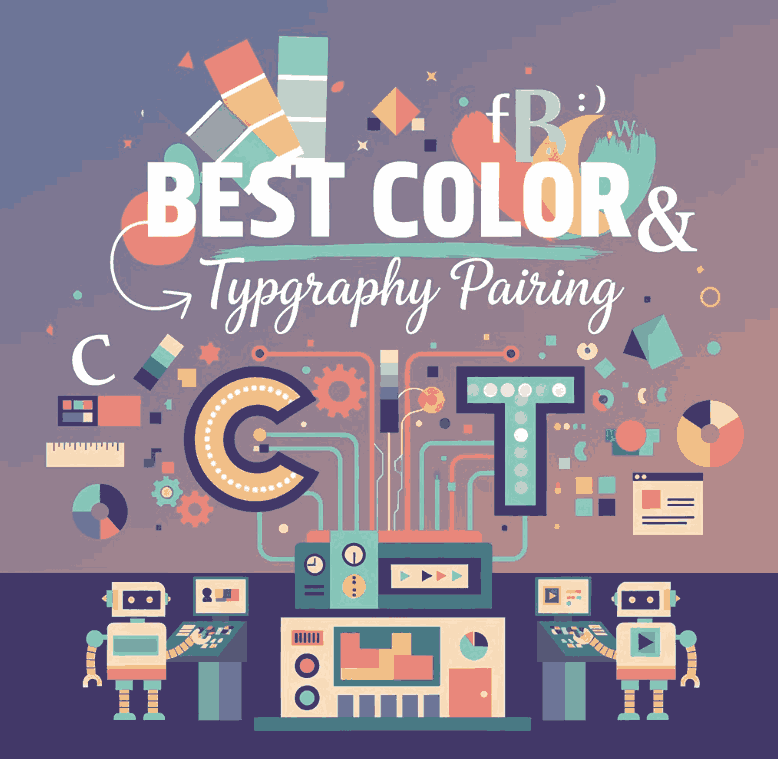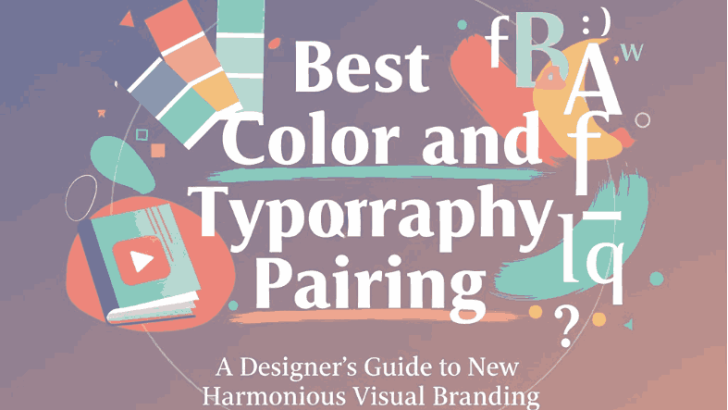Table of Contents
- Why Color & Typography Pairing Matters
- Principles of Effective Color and Font Combinations
- How to Choose the Right Pairing for Your Brand
- Showcasing Fonts from Edric Studio for Strong Color + Typography Pairings
- Common Mistakes & How to Avoid Them
- Conclusion
- References
1. Why best color & typography pairing Matters
In visual branding, both best color & typography pairing and color carry distinct semantic weight. Color triggers emotional responses in milliseconds, while typography sets expectations about a brand’s personality, tone and trustworthiness.
When these two elements are thoughtfully paired, they work together to reinforce messaging, improve readability, and create a memorable brand experience. For example, a financial brand using deep blues with a clean sans-serif evokes reliability; by contrast, a playful startup using bright neon with a script typeface sends a very different signal.
Thus, for a foundry like yours at Edric Studio, offering fonts that not only look great but also respond well to color contexts adds meaningful value for your customers.

2. Principles of Effective Color and Font Combinations
Here are key design principles you should be aware of when combining color and typography:
2.1 Understand the emotional language of color
Colors communicate. Different hues evoke distinct emotions and associations (e.g., blue = trust, green = growth, red = energy).
Selecting a color palette aligned with brand values is foundational before even looking at font choices.
2.2 Match typography to tonal cues
Typography conveys voice—serifs might feel traditional and trustworthy, sans-serifs modern and clean, scripts or decorative fonts expressive or artisanal. It’s important the font reflects the same mood as the color palette.
2.3 Maintain contrast and readability
A great color + typography pairing ensures readability: sufficient contrast between text and background, font sizes and weights that make sense. Poor contrast undermines user experience.
2.4 Create harmony & hierarchy
Your color and font choices should harmonize (so they don’t clash) and support a visual hierarchy (so the viewer’s eye is guided through the content).
2.5 Adapt for context and medium
Remember that digital vs print, small screens vs large formats, light vs dark mode—all these affect how your color + font pairing performs. A pairing that works in print might struggle on mobile.
By adopting these principles, you equip your fonts (and your customers) to succeed across brand contexts.
3. How to Choose the Right best color & typography pairing for Your Brand
Here is a practical workflow for selecting a strong color + typography pairing:
- Define your brand personality
Is the brand premium or budget? Playful or serious? Modern or heritage? These distinctions guide both color and typography choices. - Select a palette with purpose
Choose primary and secondary colors that reflect your brand personality. Reference color psychology to guide your selection. - Choose a typeface that supports your tone
Pick a font that aligns with your brand’s voice. For display work, decorative or character-rich fonts may suit; for body copy, go for legibility. - Pair color and font deliberately
- For example: Bold color with a clean sans-serif can feel modern and energetic.
- Muted palette with a textured serif may feel vintage and artisanal.
- Bright accent colors paired with a strong display font can generate attention for campaigns.
- Test for readability & contrast
Always check dark text on light background and light text on dark background. Ensure your typography remains legible in real contexts (mobile, print, signage). - Create system rules
Define in a brand style guide how the color and typography pairing should be used (e.g., headline font in primary color, body in secondary neutral). - Flex but keep consistency
Trends change, but your core pairing should have staying power. You may introduce accents or seasonal variants, but maintain a consistent foundation.
By following this process, your fonts and color systems will work in unison to reflect brand identity, rather than at cross-purposes.
4. Showcasing Fonts from Edric Studio for Strong Color + best color & typography pairing
Here are four fonts from your collection that are particularly well-suited for strong color and typography pairings in brand systems:
- Blacked Font – A bold display font with strong presence. Ideal for headlines or brand marks. Pair it with a vibrant accent color for high impact or a muted backdrop for sophisticated appeal.
- Temptation Font – A more decorative script or character-rich font (assuming from the name) suited for expressive brands (fashion, luxury, lifestyle). Combine with a minimal palette (e.g., monochrome plus one accent) so the typography remains the hero.
- Ailza Bright Font – Feels fresh and modern, which makes it versatile for digital branding. Pair it with bright, clean colors (turquoise, lemon, coral) for youthful brands, or cooler tones (steel, navy) for elevated context.
- **Bob Gerry Font** – Perhaps a distinctive sans or serif with character. Use it in a brand system where body copy needs readability but headlines retain personality. Colors like warm greys + terra-cotta or deep navy + gold might pair well.
Linking these font pages gives readers concrete examples, shows how your typefaces respond to color systems, and drives interest to your product line. From a conversion standpoint it’s a smart combination of editorial value + product exposure.

5. Common Mistakes & How to Avoid Them
Even seasoned designers slip up when pairing color and typography. Here are common pitfalls and how to avoid them:
Mistake #1: Choosing a font purely on style-without considering color context
A beautiful font may look amazing in black on white but fail in colored backgrounds or small sizes. Always test the font in the actual color scenarios you intend.
Mistake #2: Using trending color palettes but mismatching best color & typography pairing
A trendy palette (e.g., neon, pastel) may demand a certain typographic style (e.g., minimal, modern) — mismatch them and you get dissonance. Instead, ensure the typography vibe aligns with color tone.
Mistake #3: Ignoring readability for aesthetics
Decorative fonts + flashy colors = risky readability. Especially body text in complex color/typography pairing will hamper user experience.
Mistake #4: Over-complicating the system
Too many fonts or too many accent colors lead to brand incoherence. Establish a limited and consistent pairing system: one headline font + one body font + one or two brand colors.
Mistake #5: Neglecting cross-medium adaptation
A color + font pairing might look great on desktop print but fall apart on mobile or dark mode. Always test across platforms.
By being aware of these and applying best practices, you elevate not just your own font designs but also help your customers use them more effectively in real branding contexts.
6. Conclusion best color & typography pairing
Pairing color and typography is far more than an aesthetic choice—it’s a strategic decision that shapes how a brand is perceived. The best color & typography pairing reflects brand personality, ensures readability, builds hierarchy, and adapts across mediums.
As a font foundry, your work at Edric Studio plays an important role: you craft typefaces that will serve these systems. By positioning your fonts (such as Blacked, Temptation, Ailza Bright and Bob Gerry) within color-typography systems, you’re helping customers not just choose fonts, but create entire visual brand strategies.
When designers understand how to align palette, type, and application, the result is a visual identity that resonates, endures and stands out.
7. References best color & typography pairing
- Webflow Blog – Color and Typography Pairings: A Designer’s Cheatsheet.
- Deesignre – How to Complement Typography with the Right Colors.
- LaughtonCreatives – Colour Palette and Typography in Brand Identity Design.
- Pressidium Blog – A Guide to Font Pairing for Web Designers: Tips + 30 Amazing Examples!.

